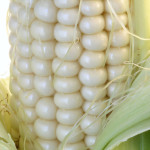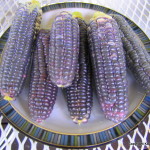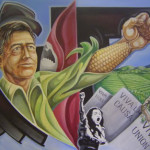As discussed in class and as Dr. Perez noted, corn is significant in The Hungry Woman and in indigenous cultures of the Americas. Corn is of the earth, and corn is life. As Dr. Perez pointed out, the Cihuatateo (El Coro) in The Hungry Woman are not only identified by the four directions, but also the four primary colors of Pre-Columbian culture. These colors could possibly symbolize various types of corn. The above images of the colored corn noted for El Coro: EAST (Red), NORTH (Black), WEST (White), and SOUTH (Blue) (Moraga 8). There is also an image of a mural by Roy Villalobo, who depicts Cesar Chavez emerging from a corn stalk, and his arm has become a cob of corn. Corn is of the earth and corn is life. The final image is of the powerful Aztec corn goddess, Xilonen. She is generally found holding a double ear of corn in each hand.
The Maize Project at the University of Georgia notes the great diversity found in corn. They state, “One of the major sites that preserve the genetic varieties of corn is the US Department of Agriculture’s Plant Introduction Station in Ames, Iowa. They hold 19,780 different samples or “accessions” of corn from around the world. The diversity of corn found in those accessions reflects physical differences in seed color, shape and texture, but also the physiological differences that make some varieties suited to growing in desert environments or the wet tropics. These seeds hold the genes that have accumulated through natural and human selection over hundreds or even thousands of years” (http://maize.uga.edu/index.php?loc=diversity). Both in historical and contemporary times, the type of corn that is grown in a particular region is determined by its ability to grow in those specific conditions, as well as the people’s purpose for the crop. In addition to yellow, white, and red varieties, this site also has images of Oaxacan Green, which is a variety grown by Zapotecs, the multicolored Acoma Pueblo, and the Hopi Blue. There are also heirloom and thousands of hybrid varieties. Landraces are among the oldest varieties of corn, found in the Mexican highlands.
In The Hungry Woman, Medea yearns for her Aztlan homeland, where a mestiza with a substantial amount of indigenous blood can claim her inheritance. This tie to the mestiza consciousness, indigeneity, and yearning for a homeland, also have strong ties to corn. In Our Lady of Guadalupe: Faith and Empowerment among Mexican-American Women, Jeanette Rodriguez (2005) quotes the late Gloria Anzaldua, “‘Indigenous like corn, like corn, the mestiza is a product of crossbreeding, designed for preservation under a variety of conditions. Like an ear of corn–a female seed-bearing organ–the mestiza is tenacious, tightly wrapped in the husks of her culture. Like kernels she clings to the cob; with thick stalks and strong brace roots, she holds tight to the earth–she will survive the crossroads'” (62).
Works Cited:
Moraga, Cherrie L. The Hungry Woman. Albuquerque: West End Press, 2001. Print.
Rodriguez, Jeanette. Our Lady of Guadalupe: Faith and Empowerment among Mexican-American Women. Austin: University of Texas Press, 2005. Print.
University of Georgia Maize Project: http://maize.uga.edu/index.php?loc=diversity
Images Used:
Red Corn Image: http://foodblogga.blogspot.com/2008/09/edible-red-corn-on-cob.html
White Corn Image: http://2.bp.blogspot.com/_QnwYStOcWGE/TEgmbHtb1tI/AAAAAAAABo4/U-FJhyovWac/s1600/cornmd.jpg
Black Corn Image: http://www.seedsofchange.com/seedswfs/corn_dakota_black.jpg
Blue Corn Image: http://www.bubblews.com/assets/images/news/81865047_1381640140.JPG
Cesar Chavez Mural Artist: Roy Villalobo
Cesar Chavez Mural Image: http://i117.photobucket.com/albums/o45/karrie_026/CESAR-CHAVEZ-ART1.jpg
Aztec Corn Goddess Xilonen Image: http://www.paganspace.net/photo/1342861:Photo:264535?context=user






